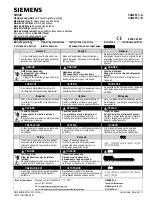
41-748.31B
4
KLF-1 Loss-of-Field Relay
impedance and directional units energize the time
delay circuit which operates the X unit after .4 ±.05
seconds.
The operation of impedance, directional and X unit
sounds an alarm, and the additional operation of the
under voltage unit trips the machine. This time delay
is to insure positive contact coordination under all
possible operating conditions. During a seismic event
which exposes the relay to a ZPA level of 5.7g, the
operate time of the X unit may vary from .25 second
to 1.25 seconds due to bounce induced in the Z and
D contacts. During normal conditions, all contacts
are open.
3.1
PRINCIPLE OF IMPEDANCE UNIT OPERA-
TION
The impedance unit is an induction cylinder unit hav-
ing directional characteristics. Operation depends on
the phase relationship between magnetic fluxes in
the poles of the electromagnet.
One set of opposite poles, designated as the operat-
ing poles are energized by voltage V
AG
modified by a
voltage derived from the long reach compensator T
A
.
The other set of poles (polarizing) are energized by
the same voltage V
AG
except modified by a voltage
derived from the short reach compensator T
C
: The
flux in the polarizing pole is so adjusted that the unit
closes its contacts whenever flux in the operating set
of poles leads the flux in the polarizing set.
Reach of the impedance unit is determined by com-
pensators T
A
and T
C
as modified by autotransformer
settings. Compensators T
A
and T
C
are designed
so that its mutual impedance Z
A
or Z
C
has known
and adjustable values as described below under
CHARACTERISTICS and SETTINGS. The mutual
impedance of a compensator is defined here as
the ratio of secondary induced voltage to primary
current and is equal to T. Each secondary com-
pensator voltage is in series with voltage V
AG
.
Compensator voltages are equal to I
A
Z
A
for long
reach compensator and I
A
Z
C
for short reach com-
pensator, where I, is the relay current.
Figure 5 (page 23) shows how the compensation
voltages I
A
Z
A
and I
A
Z
C
influence the R-X circle.
Note that Z
A
independently determines the “long
reach”, while Z
C
independently fixes the “short
reach”. With the reversing links in the normal posi-
tion (+Z
C
) the circle includes the origin; with the
opposite link position (-Z
C
) the circle misses the
origin. The following paragraphs explain this com-
pensator action.
Referring to Figure 6 (page 23) note that X
C
and
C
C
cause the polarizing voltage to be shifted 90° in
the leading direction. Thus, when the current is
zero, polarizing voltage V
POL
leads the operating
voltage V
OP
by 90°, as shown in Figure 6(a). This
relation produces restraining torque. To illustrate
how Z
A
fixes the long reach, assume a relay cur-
rent which leads V
AG
by 90° and of sufficient mag-
n i t u d e t o o p e r a t e t h e r e l a y . T h i s m e a n s t h e
apparent impedance is along the -X axis. Note in
Figure 6(b) that the Z
A
compensation reverses the
operating voltage phase position. The relay bal-
ances when this voltage is zero. Note that this bal-
ance is unaffected by the Z
C
compensation, since
this compensation merely increases the size of
V
POL
.
For lagging current conditions note in Figure 6(c)
how V
POL
is reversed by the Z
C
compensation. In
this case Z
A
compensation has no effect on the
balance point. This explains why the short reach
point is fixed independently by Z
C
.
Figure 6 (page 23) assumes that +Z
C
is positive
(circle includes origin). If the current coil link is
reversed, the compensation becomes -Z
C
. In Fig-
ure 6(b) this change would result in, V
POL
being
reduced rather than increased by the compensa-
tion. As the current increases V
POL
will finally be
reversed, re-establishing restraining torque. Thus,
the current need not reverse in order to obtain a
“short-reach” balance point. Instead the apparent
impedance need only move towards the origin in
the -X region to find the balance point. Therefore,
t h e c ir c l e d o e s n o t i n c l u d e t h e o r ig i n w i t h a
reversed link position.
4.0
CHARACTERISTICS
The type KLF-1 relay is available in one range. Long
Reach is 2.08 to 56 ohms. Short Reach is 0.79 to
18.0 ohms.
4.1
IMPEDANCE UNIT
The impedance unit can be set to have characteristic
circles that pass through the origin, include it, or
exclude it, as shown in Figure 5 (page 23).
The Z
A
and Z
C
values are determined by compensa-
tor settings and modified by autotransformer settings
S, L, and R. The impedance settings in ohms reach
can be made for any value from 2.08 to 56 ohms for
Z
A
, and from 0.79 ohm to 18 ohms for Z
C
in steps of
3 percent.





































